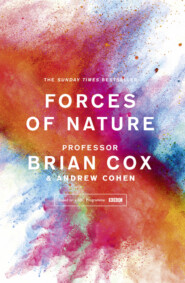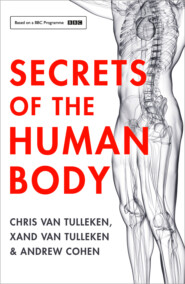По всем вопросам обращайтесь на: info@litportal.ru
(©) 2003-2024.
✖
Wonders of Life
Автор
Год написания книги
2019
Настройки чтения
Размер шрифта
Высота строк
Поля
This light micrograph shows cyanobacteria, or ‘blue-green algae’, which use phycocyanin to capture the energy of the Sun.
Take a look at this picture – it’s an image of a very particular type of bacteria. Look very closely at it because you have a lot to thank this particular kind of organism for. These are cyanobacteria – lowly bacteria that sit at the very bottom of the food chain. They’re the most numerous organisms on the planet. There are more of them on Earth than there are observable stars in the Universe, and these little creatures are what enabled you – and every other complex living thing that has ever lived on the planet, from dinosaurs to daffodils – to exist.
If you look at the picture carefully, you will see that, unlike the other monochromatic bacteria, this one is bursting with a kind of blue-green colour, which comes from a pigment known as phycocyanin – exactly the kind of pigment that would offer an organism protection from the Sun’s damaging UV radiation. But these bacteria don’t just use the pigment for protection, they use it to capture the energy of the Sun.
A BREATH OF FRESH AIR (#ulink_74f476fa-377b-518c-9597-2e20e380c0af)
Today cyanobacteria are sometimes considered to be a problem. This image, although beautiful, is of a bloom of ‘blue-green algae’- or, more correctly, cyanobacteria – in Lake Atitlán in the Guatemalan Highlands. It provides a vivid example of bacteria reproducing at a ferocious rate, and, in some cases, this explosion of life can have a devastating effect on an ecosystem. Toxins produced by the bacteria can decimate water life and affect human health, so they are closely monitored by environmental agencies around the world. But we have cyanobacteria to thank for the oxygen we breathe, because it is a virtual certainty that oxygenic photosynthesis evolved in an ancient cyanobacterium.
The way to unravel the story of the evolution of the Z scheme is to look at how each individual part may have arisen. There is evidence that an early form of photosynthesis may have emerged as far back as 3.5 billion years ago in single-celled organisms that produced enigmatic mounds known as stromatolites (see Chapter 3 (#litres_trial_promo)), although the precise date is still an area of active debate and research. Whatever the date, there is general agreement that a simple form of photosynthesis, using energy from the Sun to synthesise sugars from carbon dioxide, just as photosystem I does in plants today, is very ancient. The pigment used today is chlorophyll, a member of a family of molecules known as porphyrins. Complex though they are, porphyrins have been found on asteroids, implying that they form naturally and are likely to have been around on Earth before the origin of life. There are still bacteria alive today that have only photosystem I. They take their electrons from easy targets, such as hydrogen sulphide or iron, and don’t therefore need much else in the way of machinery.
Over time, it is thought that some bacteria adapted this early photosynthetic machinery to perform a different task – the production of ATP. There are similarities between the two photosystems that strongly suggest a common origin and later specialisation.
Cyanobacteria are able to reproduce rapidly, and this can have a devastating impact on an ecosystem. This satellite image of Lake Atitlán in Guatemala shows blooms of cyanobacteria, caused by polluted runoff from the surrounding land.
The evolution of early versions of photosystems I and II in bacteria is therefore relatively well understood; their components are simple, and the chemistry reflects that occurring naturally on the early Earth. Things become more interesting, however, when we ask how these two machines came to be joined together in the Z scheme. While biologists don’t yet agree on the answer, one of the more elegant hypotheses, due to Professor John Allen at Queen Mary, University of London, and detailed in Nick Lane’s excellent book, Life Ascending, is as follows.
While some bacteria employed the precursor of photosystem I, and others used the precursor of photosystem II, there may also have been bacteria that possessed the genetic coding necessary to build both photosystems. This would allow them to switch between them, depending on environmental conditions and the availability of food. This is a relatively common thing for bacteria to do today; their genes can be switched on and off, allowing them to make hay while the sun shines – or at least, in this case, to use sunshine to make sugar or ATP, depending on whether the imperative is to reproduce or simply to survive. The possibility of an ingenious evolutionary adaptation now presents itself. What if it were possible to run these two machines at once, connecting the electron circuit from photosystem II into photosystem I, which would dutifully dispose of the cascade of electrons by pushing them onto carbon dioxide to form sugar? This would confer a great advantage on the organism in question, allowing it to make both food and ATP at the same time using sunlight as an energy source. This is certainly a plausible explanation for the separate evolution and then recombination of the two photosystems, but it leaves one remaining question: where does this machinery get its electrons? Here is where the Oxygen Evolving Complex enters the story and, with it, one of the most important evolutionary steps in the history of life on Earth.
The Oxygen Evolving Complex is an odd structure: more mineral than biological. It consists of four manganese atoms and a single calcium atom, held together in a lattice of oxygen. Manganese is locked away in vast mineral deposits on the ocean floor today, but in the early history of our oceans it would have been available in seawater for organisms to use. Bacteria use manganese to protect them from UV light, in much the same way as we use melanin – manganese is easily ‘photo-oxidised’, absorbing the potentially harmful UV photon and releasing an electron in the process. This may have been one of the ways in which electrons made their way into the primitive photosystem II in early bacteria. So manganese, at least, was already an important component of living things from the earliest of times. Today, manganese performs a different task. It sits at the heart of the Oxygen Evolving Complex, whose job is to grab water molecules and hold them ready for electrons to be ripped off and used as input into photosystem II. As a result, water molecules are split apart and, just as in the electrolysis of water so beloved of Mr Bell (see here (#ulink_e2c5ca5e-6295-5a9d-92eb-0855361398fc)), oxygen is released as a gas.
Bacteria genes can be switched on and off, allowing them to make hay while the Sun shines – or at least to use sunshine to make sugar or ATP.
This theory is a piece of cutting-edge research. The structure of the Oxygen Evolving Complex was determined only in 2006, and it is only in the last few years that the locations of each of the 46,630 atoms in photosystem II have been mapped. There are therefore many details in this story yet to be uncovered, but the broad sweep we have outlined here is certainly a strong candidate for an explanation of how the complexity of the Z scheme arose.
There is one last quite wonderful sting in the tail of this story, however, and it is something we know for certain: oxygenic photosynthesis evolved only once.
The evidence for this rather definite statement is clear when we look down a microscope at the structures inside plants and algae that carry our photosynthesis. They are called chloroplasts, and they are all self-evidently related to each other because they are so similar. But there is more than this, because they look for all the world as though they were cyanobacteria living inside the leaves, just like those found today in the blooms on Lake Atitlan. This is because that is exactly what they are. They even maintain their own independent rings of DNA, just as free-living bacteria do today.
But how does one cell end up inside another? At some point in the history of life on Earth, a cyanobacterium cell must have been engulfed by another cell and, instead of being digested, it survived to perform a useful purpose. This process, called endosymbiosis, has happened more than once in the history of life on Earth; indeed, it is thought to have been fundamental in the evolution of complex life. Endosymbiosis allows for great leaps in the capability of living things – a merger of fully formed skills to produce a result greater than the sum of the parts. In the case of oxygenic photosynthesis, this particular example of endosymbiosis led to the evolution of two of the great kingdoms of life – the algae and the plants – by allowing machinery evolved over billions of years inside cyanobacteria to be co-opted into more complex multi-cellular organisms.
A coloured electron micrograph of a leaf of Zinnia elegans, showing chloroplasts (green), starch granules (pink), the nucleus (red), and a large vacuole (white). The large air spaces allow for gas exchange during photosynthesis.
This coloured electron micrograph shows two chloroplasts in the leaf of a pea plant (Pisum sativum). Chloroplasts convert light and carbon dioxide into carbohydrates.
The quite dizzying conclusion is that, because everything that carries out oxygenic photosynthesis today does so in precisely the same way, we owe the beauty of life on Earth – with its hues, colours and seemingly limitless diversity – to a cyanobacterium whose ancestors, somehow, found their way inside another cell. The descendants of that cell are still present on Earth today, inside every leaf, every blade of grass and every algal bloom, and they have filled our atmosphere with oxygen.
A coloured electron micrograph of the inside of a chloroplast’s thylakoid membrane, containing the green pigment chlorophyll.
BREATH OF LIFE (#ulink_4f581387-3084-57dd-a7fb-fbbe56e632d5)
As levels of atmospheric oxygen rose, the Earth began to rust. Evidence of this rusting can be seen at Rockham beach, North Devon, where deposits of iron oxide appear as orange patches.
For almost half of Earth’s history, one of the most important ingredients for complex life was absent from the Earth’s atmosphere. Oxygen is an unstable, reactive gas that must be constantly replenished. The first rush of oxygen released from water by the cyanobacteria did what oxygen does best, reacting with the myriad elements present on Earth’s primordial surface to form oxides. In our planet’s infancy, large amounts of iron could be found in the oceans and, to a lesser extent, on land. Left over from the Earth’s formation, this dissolved iron remained stable for billions of years, but as the levels of atmospheric oxygen began to rise, a very familiar reaction began to take place. The Earth began to rust. Today, across the planet the evidence of this global rusting can be found in deposits of iron oxides known as banded iron formations.
Oxygenic photosynthesis doesn’t automatically fill the atmosphere with oxygen, however. It is necessary, but not sufficient, because both rusting and respiration act to undo all the good works of the plants, algae and cyanobacteria, and remove oxygen from the atmosphere. While photosynthesis takes carbon dioxide out of the atmosphere and turns it into organic matter, aerobic respiration takes organic matter and burns it using oxygen, releasing carbon dioxide and water. These processes will naturally reach a balance, which is why oxygen levels today have been stable at around 21 per cent for many millions of years. In order to change oxygen levels, something has to happen. It is known that oxygen levels first increased on Earth around 2.4 billion years ago, a time when many of the great banded iron formations were laid down. This rise may have been triggered by the complete oxidation of the Earth’s iron and other elements, which until that time acted as a sink, removing the photosynthetic oxygen from the atmosphere as quickly as the bacteria could release it. This is one plausible scenario, although there is not widespread agreement on the reason for this ‘Great Oxidation Event’, and it is still a very active area of research. Whatever the reason, the oxygenation of the atmosphere made possible by the evolution of oxygenic photosynthesis was critically important for the emergence of complex animals.
VARIATION OF ATMOSPHERIC OXYGEN CONCENTRATION OVER THE LAST 3.5 BILLION YEARS
Aerobic respiration, in which energy is released from organic matter, makes the existence of food chains possible because it is so efficient. Releasing energy from food using oxygen is around 40 per cent efficient, while oxidising food using iron or sulphur is only around 10 per cent efficient. This means that animals can eat plants, and in turn get eaten by a tower of predators that can still extract enough energy to flourish. It is almost certainly no accident that the Cambrian explosion – the rapid diversification of life resulting in the emergence of virtually everything we would regard today as complex – followed (on geological timescales) a rapid increase in atmospheric oxygen levels.
BRINGING IT ALL BACK HOME
The story of the emergence of today’s Earth is complex. That we understand not only the broad sweep of the narrative, but also the fine detail of at least some of the chapters, is one of the great achievements of science, and the presence of some uncertainties in the story of the emergence and development of a 4-billion-year-old biosphere is surely unsurprising. We have seen that water is a prerequisite for life on Earth, and most likely for life anywhere in the Universe. Likewise, an oxygen atmosphere, while not necessary for microbes, is a vital component of a complex ecosystem able to support large predators and prey, and probably therefore intelligent civilisations. As oxygen atmospheres are inherently unstable, oxygenic photosynthesis on a global scale is necessary to maintain high levels of this life-giving gas. And we know that this evolved only once on Earth. But there is one final ingredient that is more elusive and certainly beyond life’s control: time. It is a certainty that the evolution of complex life requires an ecosystem that is stable over many millions of years. But how many millions? This question will occur again and again throughout this book. Why did life emerge so soon after the birth of our planet, only half a billion years after its formation? And how did the first life blossom into the magnificent complexity we see on Earth today? A good place to start is to look at the evolutionary history of a single animal, and see how precisely we can trace its origins back into the deep past.
FOUR-LEGGED LIFE STORY (#ulink_b2cebb21-4ebc-53b1-b7f6-2f2310ed1871)
The family tree of the horse is the best known of any complex animal, partly due to the wealth of available fossil evidence. The first animal recognisably ‘horse-like’ is the Hyracotherium (once known as ‘Eohippus’ or ‘dawn-horse’), which lived around 50 million years ago. It was a fox-sized omnivore, and because many thousands of intact skeletons have been found, a great deal is known about its form and lifestyle. Alterations in the availability of food probably played a role in the later emergence of two other species, the Orohippus and Epihippus, both better adapted to a browsing diet of tough plants. Around 30 million years ago, changes in climate saw the emergence of grasslands and steppe landscapes across the planet. In North America, the Mesohippus emerged; with longer legs and a slightly larger frame, it was better adapted for life on the new grassy plains because it could run faster to avoid predators. At around the same time, a species known as the Miohippus appears in the fossil record. It probably lived alongside the Mesohippus, but over time gradually replaced it. This raises an important point relating to the construction of a family tree. It should not be read as a gradual transition from the simple to the complex, culminating somehow in the grandeur that is a modern domestic horse. The different species were adapted to different conditions, occupying different ecological niches. None was ‘better’ than another in any absolute terms. Because all that remains of these animals are their fossils, and our knowledge of the local ecology is generally rudimentary, it is often difficult to know why one species survived while another died out, or why a particular species arose through a process of ‘speciation’. We will explore the phenomenon of speciation in much more detail in Chapter 5 (#litres_trial_promo). The domestic horse should therefore be seen as one of many branches of a complex family tree that survives today – it is not the culmination of a series of ‘improvements’ over its more distant ancestors.
That said, it is still instructive to follow the tree, because it illustrates the surprising pace of change delivered by the power of evolution through natural selection. Over around 25 million years, the Miohippus has given rise to a grand array of species, forever passing on a shifting mixture of genes, filtered by the sieve of natural selection. As conditions changed, some branches of the tree turned out to be evolutionary cul-de-sacs, while others lived on, branching or gradually changing. This continuously shifting selection and isolation of pools of genes is reflected in the diversity of the horse family that we can see today – from zebra to the Yucon wild ass, from the kiangs of Tibet to Equus ferus caballus (the domestic horse).
So we can see that changes in form can be rapid and surprising. The Hyracotherium looks more like a fox, or even a large rodent, than a horse, and yet in the history of every modern horse, Przewalski’s horse, zebra or donkey there are Hyracotherium ancestors who lived only 50 million years ago – the blink of an eye in the 4.5 billion years’ life of our planet.
If we sweep back still further, we encounter the first mammals around 225 million years ago. There is an explosion of complexity in the fossil record associated with the Cambrian period, 530 million years ago, which may have been related to a rise in oxygen levels. The first evidence of complex multicellular life appears around 600 million years ago in the form of the Ediacaran biota, named after fossils first found in the Ediacaran hills in Australia. Some of these organisms had a quilted, fractal appearance and were so bizarre that it has been suggested they were neither animals, nor plants, nor fungi, but some failed evolutionary experiment. Other Ediacarans were clearly soft-bodied animals, up to 2 cm in length with a head, and may even have burrowed slightly into the microbial mats on the sea bottom, thereby subtly changing the planet’s ecology, and opening the way for further evolutionary developments. The delicate and ambiguous nature of the fossils left by these mysterious organisms has made the study of the Ediacara one of the most intriguing parts of recent palaeontology.
Before the earliest Ediacaran fossils, dated at 655 million years old, there is no direct evidence of multicellular life on Earth. The next major milestone occurred around 2 billion years ago with the emergence of the eukaryotic cell. As we have already discussed, eukaryotes are cells with a nucleus and internal structures similar to our own – we are grand colonies of eukaryotic cells. At around 3.5 billion years ago, we find the first prokaryotes, the first free-living cells that emerged, perhaps, from hydrothermal vent systems on the ocean floor of the primordial Earth.
The reasons for these vast periods of apparent stasis in the development of life – over a billion and a half years from prokaryote to eukaryote and a similar amount of time from the eukaryote to the first evidence of multicellular life – are not understood. It certainly seems that the complex cell – the eukaryote – emerged only once in the history of life. There is no evidence of different versions of the eukaryotic cell emerging from bacteria or archaea during their 4 billion-year tenure on Earth. If they did, they have left no trace. All animals, plants, algae and fungi are self-evidently related to each other, sharing multiple traits from the structure of their DNA to the use of ATP. The form and biochemistry of their cells are very similar; only the colonies they form are radically different. This strongly suggests a common ancestor, and raises the intriguing question: was the emergence of the eukaryote an incredibly unlikely event, or was the billion-year delay just bad luck? We don’t know, because we have only one Earth to observe. This is why the search for microbial life elsewhere in the Solar System is so desperately important.
There is something on which everybody agrees, however: as first proposed by the late Lynn Margulis, the eukaryote is a chimera, formed by endosymbiosis in much the same way as the ancestors of plants and algae acquired their chloroplasts. The evidence for this lies in structures known as mitochondria, found in the overwhelming majority of eukaryotic cells alive today and responsible for the generation of ATP through respiration. We will meet mitochondria in more detail in Chapter 2 (#litres_trial_promo). Just as for the case of the chloroplasts, however, mitochondria have their own loops of bacterial DNA that mark them out as ancient bacterial symbionts. Furthermore, eukaryotes bear an interesting genetic relationship with the two prokaryotic branches of life – bacteria and archaea. They share genes with both, which strongly suggests that the first eukaryote was the result of a merger between a bacterium and an archaea. The details are still the subject of debate, but it seems that something very unlikely indeed – the successful merger of two prokaryotic cells – had to happen before complex life could develop on our planet. The eukaryote is probably a happy accident. And, therefore, so are we.
This may have profound implications for the existence of complex life on other planets. The emergence of prokaryotes may well be inevitable, given the right conditions. We will explore this in much more detail in the following chapter. But there is no way we know of that prokaryotes will clump together to form animals, plants and people – at least they haven’t managed it during their 4 billion years on Earth. To build Apollo 8, you first need a eukaryote, and it seems probable that on Earth this key step occurred due to blind luck, followed by a lot of natural selection. It took almost 2 billion years for it to happen on our planet – 2 billion years in which the oceans remained a stable, hospitable home under a dangerous Sun. Could it be that living things capable of taking pictures of their home from space are rare or even unique to Earth? Perhaps one day we will know, but, lonely or not, we have surely learnt enough about life’s long struggle to complexity to treasure the good Earth.
Вы ознакомились с фрагментом книги.
Приобретайте полный текст книги у нашего партнера:
Приобретайте полный текст книги у нашего партнера:










